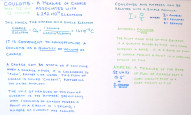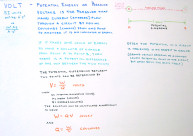Chapter 1-1 : Basic Electrical Quantities
- The most elemental quantity is electric charge.
- Charge is measured in coulombs.
- The charge on an electron is negative and is equal to 1.591 X 10-19 coulomb.
- A field of force exists in the vicinity of a charge. This is the electric field.
- Charges must move in order to make an energy transfer.
- The rate of motion of charge in a circuit is called the current.
- The unit of current is called the ampere; one ampere exists when charge flows past a point in a circuit at the rate of one coulomb per second.

where
 is in amperes,
and
is in amperes,
and  is the change in coulombs over the change in time.
is the change in coulombs over the change in time.
A whiteboard discussion of the concepts of coulomb and ampere may help to clarify the points a little bit.

Click to Enlarge
Going the other direction,

where
 is in coulombs and is the summation of the product of
is in coulombs and is the summation of the product of
 , amperes, and
, amperes, and
 , the change in time.
, the change in time.
- Charge is the quantity that flows through a circuit whereas current is a rate, that being, the time rate flow of charge.
- Current is a vector quantity; it has both magnitude and direction.
- The potential difference between two points in a circuit is the work or energy involved in transferring a unit of positive charge, one coulomb, from one point to the other.
- Potential difference is measured in volts.
- Work is defined as moving a charge through a potential difference.

Click to Enlarge
The energy,
 , associated with moving a charge
, associated with moving a charge
 through a potential difference of
through a potential difference of
 volts is,
volts is,
 . This is the definition of joules or watt-secs.
. This is the definition of joules or watt-secs.
- A source of electrical energy that generates a potential difference is called an electromotive force.
- A circuit carrying current also generates another type of field of force. That is the magnetic field. Its motions, caused by a changing current in the circuit, may also cause induced voltages in other components.
- Power is the rate of energy transfer. It is the time derivative of the energy.
 , may be represented by
, may be represented by
 .
This is watts or joules/sec.
.
This is watts or joules/sec.
Where current and voltage are functions of time then it is possible to represent the total energy transfer as
 . This is watt-secs or joules.
. This is watt-secs or joules.
And when we have
 and
and
 constant, and not time dependent instantaneous values, we do not represent them in lower case, but as upper case.
constant, and not time dependent instantaneous values, we do not represent them in lower case, but as upper case.
 . This is joules.
. This is joules.